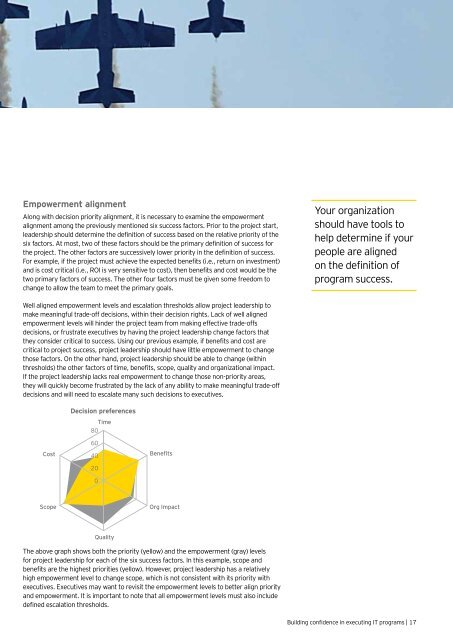Building confidence in executing IT programs
1MvMFcE
1MvMFcE
- No tags were found...
You also want an ePaper? Increase the reach of your titles
YUMPU automatically turns print PDFs into web optimized ePapers that Google loves.
Empowerment alignment<br />
Along with decision priority alignment, it is necessary to exam<strong>in</strong>e the empowerment<br />
alignment among the previously mentioned six success factors. Prior to the project start,<br />
leadership should determ<strong>in</strong>e the def<strong>in</strong>ition of success based on the relative priority of the<br />
six factors. At most, two of these factors should be the primary def<strong>in</strong>ition of success for<br />
the project. The other factors are successively lower priority <strong>in</strong> the def<strong>in</strong>ition of success.<br />
For example, if the project must achieve the expected benefits (i.e., return on <strong>in</strong>vestment)<br />
and is cost critical (i.e., ROI is very sensitive to cost), then benefits and cost would be the<br />
two primary factors of success. The other four factors must be given some freedom to<br />
change to allow the team to meet the primary goals.<br />
Your organization<br />
should have tools to<br />
help determ<strong>in</strong>e if your<br />
people are aligned<br />
on the def<strong>in</strong>ition of<br />
program success.<br />
Well aligned empowerment levels and escalation thresholds allow project leadership to<br />
make mean<strong>in</strong>gful trade-off decisions, with<strong>in</strong> their decision rights. Lack of well aligned<br />
empowerment levels will h<strong>in</strong>der the project team from mak<strong>in</strong>g effective trade-offs<br />
decisions, or frustrate executives by hav<strong>in</strong>g the project leadership change factors that<br />
they consider critical to success. Us<strong>in</strong>g our previous example, if benefits and cost are<br />
critical to project success, project leadership should have little empowerment to change<br />
those factors. On the other hand, project leadership should be able to change (with<strong>in</strong><br />
thresholds) the other factors of time, benefits, scope, quality and organizational impact.<br />
If the project leadership lacks real empowerment to change those non-priority areas,<br />
they will quickly become frustrated by the lack of any ability to make mean<strong>in</strong>gful trade-off<br />
decisions and will need to escalate many such decisions to executives.<br />
Decision preferences<br />
Time<br />
80<br />
Cost<br />
60<br />
40<br />
20<br />
0<br />
Benefits<br />
Scope<br />
Org Impact<br />
Quality<br />
The above graph shows both the priority (yellow) and the empowerment (gray) levels<br />
for project leadership for each of the six success factors. In this example, scope and<br />
benefits are the highest priorities (yellow). However, project leadership has a relatively<br />
high empowerment level to change scope, which is not consistent with its priority with<br />
executives. Executives may want to revisit the empowerment levels to better align priority<br />
and empowerment. It is important to note that all empowerment levels must also <strong>in</strong>clude<br />
def<strong>in</strong>ed escalation thresholds.<br />
<strong>Build<strong>in</strong>g</strong> <strong>confidence</strong> <strong>in</strong> execut<strong>in</strong>g <strong>IT</strong> <strong>programs</strong> | 17



